When I started running 20 years ago, someone gave me a worn copy of Galloway’s Book on Running, published ten years earlier in 1984. The book opened my eyes to a new world and literally transformed me. It inspired—nay, spoke to me—like a coach and a friend. I read it cover to cover and stared transfixed at the cheesy pencil drawing of the “Five Stages of a Runner,” wondering when and how I’d move up to the next level.
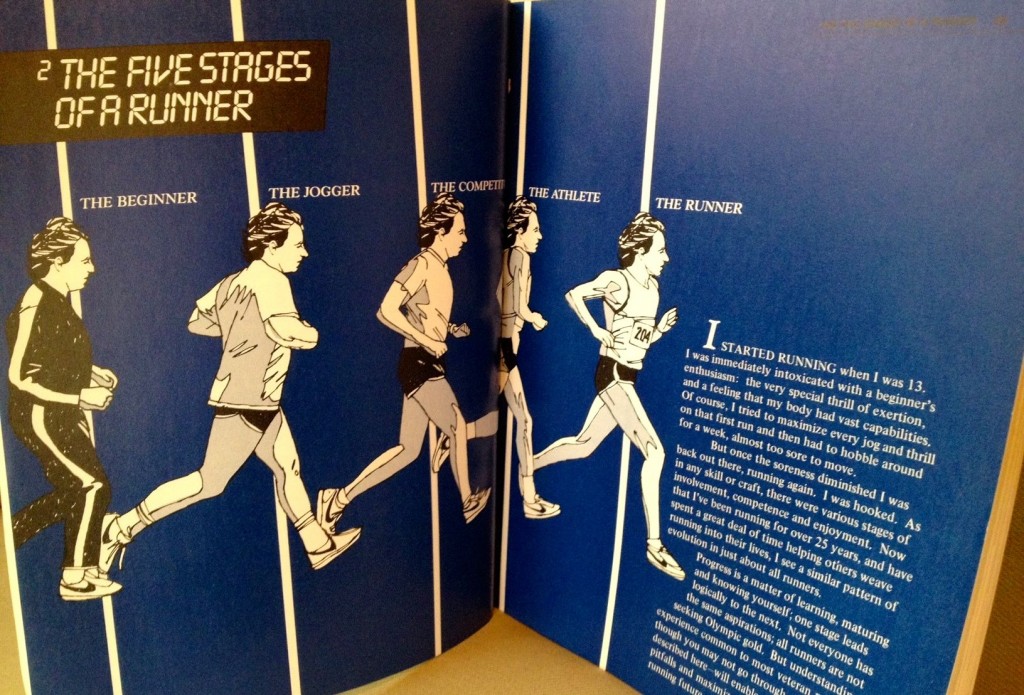
One of my favorite pages from Galloway’s classic. I so desperately wanted to graduate from “The Jogger” to “The Competitor”!
In one year, thanks in no small part to that book, I changed from a chunky, clunky beginner to someone who broke 4 hours in her first marathon. I continued to read Galloway’s articles religiously in Runner’s World and, in recent years, returned several times to the book he co-authored with Dave Hannaford, Running Injuries.
Do you get what I’m saying? I trusted this guy, this pillar of the sport, this former Olympian, Jeff Galloway.
So you might imagine my interest and eagerness to read his latest book, Trail Running, though I did approach it with some skepticism because, to my knowledge, Jeff Galloway has never been very involved with the trail/ultra scene. He’s a road runner who evangelizes the sport to the mainstream. What would happen when he hit the trails? He’d get it right, right?
Wrong. I have read quite a few books about running, and I am sorry to say this is the worst book on running I’ve ever read.
I am sorry, Jeff. I am going to give you the benefit of the doubt and assume you had very little to do with the writing and publishing of this book. I am guessing that some flack at the publishing company, Meyer & Meyer Sport (UK), got an assignment to repurpose passages from your earlier volumes, mix in some references to trail and dirt and a glossary of trail-running terms, throw in some stock images, and publish a paperback to squeeze some more juice from your substantial catalogue of book and DVD offerings.
[Note to Meyer & Meyer Sport Publishing: If you are going to produce a book about trail running, it’s not the smartest idea to run a photo of a middle-aged suburban couple strolling on pavement in road shoes while holding hands and carrying a single-use plastic water bottle. Or a photo of volunteers handing out plastic cups filled with a few sips of Gatorade. That may be how they do it at the Rock ‘N’ Roll Marathons, but it’s not the way aid stations work at trail races, and besides, we trail runners are partial to this thing called hand-held reusable water bottles and hydration packs.]
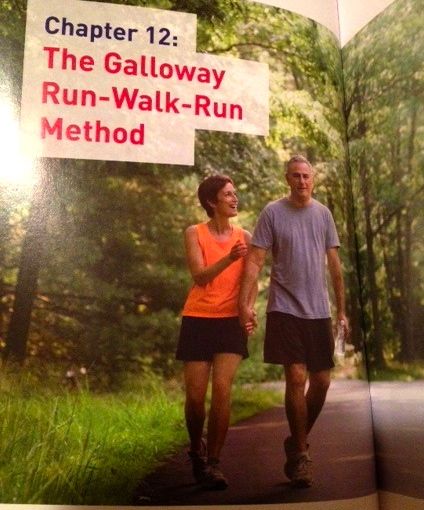
Don’t you often hold hands with your running partner? This is page 58 of Galloway’s book on walking in the park … I mean, on trail running.
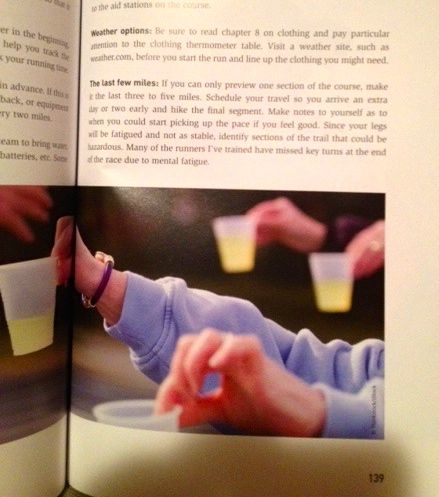
From this photo on page 139 of Galloway’s book on trail running, you can expect volunteers to hold out lots of plastic cups for you to drink from and then toss on the road when you’re done!
But what about the voice of inspiration and knowledge that comes through in Galloway’s Book on Running? In Trail Running, that nuanced, personable voice has been replaced by someone who sounds as if they’re reading instructions from a call center. Flat and dull, the overly simplistic chapters—each “chapter” consisting of a mere page or two, as if a pamphlet—made my eyes glaze over. Honestly, I can’t remember anything from the first third of the book, other than: Careful, rocks ahead! and, it’s OK to walk!
So let’s jump to the part I care most about: ultrarunning. Because it’s the part I have the most to learn about. After re-packaging his 5K, 10K, Half Marathon and Marathon training plans, he devotes a whopping NINE PAGES to a chapter on Ultra Marathon Training. You want to run a 50K to 100-mile event? Just follow the 30-week plan!
But, his sparse training plan is rather unorthodox and not very well explained. The chapter includes little advice about nutrition, hydration, mental preparedness and troubleshooting during those 50K to 100 miles. It simply says you can run three days a week (four days a week for a 100-miler), starting with 30 – 40 minutes on Tuesdays and Thursdays and a longer run on the weekend. The longer runs are divided into segments. So, for example, on Weeks 13 and 14, your weekend long run should be 4 miles one week, 5 miles the next. Then on Week 15, if you’re training for a 50-miler, your long run should be segments of 12 miles, 12 miles, 8 miles. If you’re ramping up for a 100-miler, you should jump from the 5 miles the previous week to a four-segment long run of 15-18 miles, 19 miles, 21 miles, 18 miles. Then, the following week, all training plans call a long run of just 5 miles.
Here is a picture of the training plan:
I’m picturing some guy who runs 4 miles one Saturday, 5 miles the next, and then the following weekend tells himself, “Jeff Galloway’s book says I should run three double-digit runs today.” So he heads out unprepared and either dies or wishes he were dead!
I could go into more detail about why this book is not very helpful and how much it disappointed me.
Instead, for anyone who might be in search of a good trail running book, I recommend this one, Relentless Forward Progress. Or any of these great stories laced with trail-running advice: Eat and Run,Born to Run,
or Ultramarathon Man. Or spend some quality time on sites rich with trail-running advice and links, such as iRunFar.com, run100s.com,
Trail Runner magazine, UltraRunning Magazine or A Trail Runner’s Blog, to name but a few.

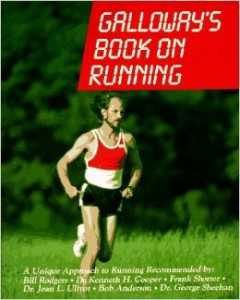
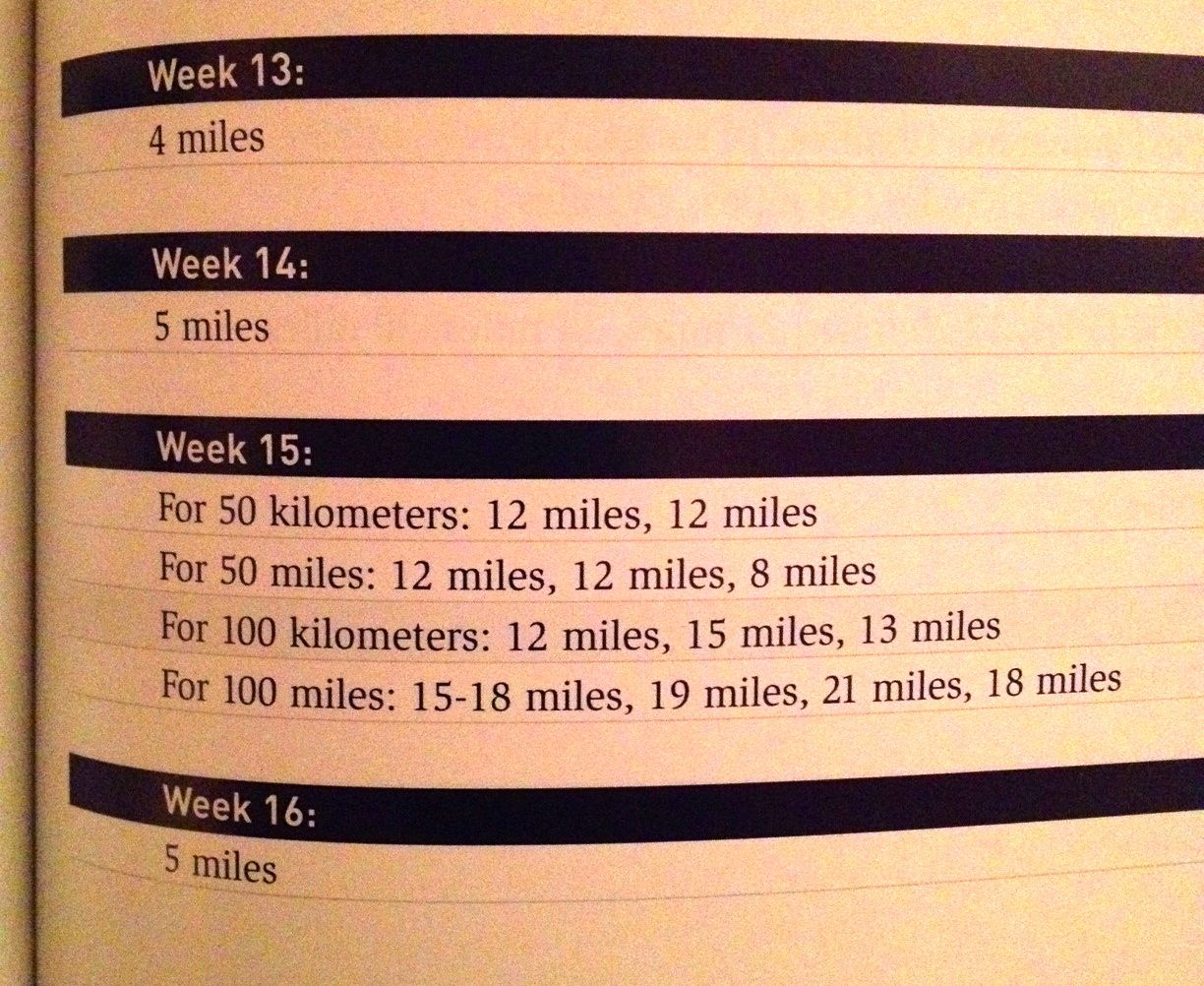
Thanks for the heads up. You should review this for Amazon, since that’s where he’ll sell the most copies. Maybe give folks a referral for Bryon’s book and the other’s you’d recommend.
Hope your running’s coming along after your injury. Happy Trails!
Love the honest review. I had Galloway’s book in high school, and used it when I started running. It’s too bad this one’s not very good.
The pic of the couple holding hands is so inane..good for a belly laugh though…
Ha! Did you get the old Galloway book from us? I remember obsessing over that book and wondering if I could hold pace for the 4-hour marathon. This post just encouraged me to buy Bryon Powell’s book, though, so thanks!
Page 127 says it all. Thanks for the warning!